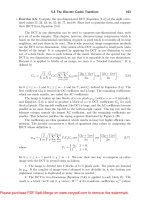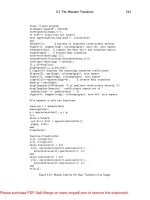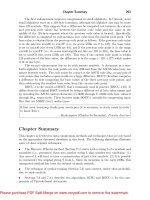Introduction to Data Access
Bạn đang xem bản rút gọn của tài liệu. Xem và tải ngay bản đầy đủ của tài liệu tại đây (213.77 KB, 28 trang )
Introduction to Data Access
W
elcome to Chapter 5, where we will lay out the cornerstones of working with databases. This
chapter is an introduction to the integration with popular Java data-access frameworks provided by
the Spring Framework. From the perspective of applications and their developers, we can say that
data access is all the Java code and other details that come with it to create, read, update, and delete
data (CRUD operations) in relational databases.
But before we can explain the Spring solutions, we need to look at the challenges of data
access. Then we will show you how Spring helps you overcome those challenges.
In this chapter, we will cover the following topics:
• Spring integration with popular data-access frameworks
• The challenges of working with data access in your applications
• The solutions to these challenges offered by Spring
• An abstraction mechanism for data-access code that you can use in your applications
• The DataSource interface and connection pools
We assume you have a basic understanding of working with databases, SQL, and JDBC. We will
be working with relational databases, and we assume that you will too. It’s also useful to have read
Chapters 1 through 4 before reading this chapter. We expect you to know about the Spring container
and its XML configuration files, dependency injection, advice, aspects, pointcuts, and join points.
Spring Integration with Data-Access Frameworks
In Java, the oldest way of carrying out data-access operations is JDBC. It’s part of the Java Standard
Edition and requires a specific driver that is supplied by your database vendor. JDBC is the standard
way of working with SQL for Java. Although JDBC is popular and has been around for many years,
it’s notoriously difficult. This is because JDBC is a low-level API that provides the basics for working
with SQL and relational databases, and nothing more. The Spring Framework makes it much easier
to work with JDBC and keeps all of its powers.
The Spring Framework integrates with all popular Java data-access frameworks. Apart from
JDBC, all the other supported frameworks are object-relational mapping (ORM) tools:
• Hibernate 2 and 3 (LGPL)
• iBATIS (Apache license, partial ORM implementation)
• Java Data Objects (JDO) 1 and 2 (specifications with commercial and open source
implementations)
• Oracle TopLink (commercial)
139
CHAPTER 5
9187ch05CMP2.qxd 7/26/07 12:19 PM Page 139
• Apache ObjectRelationalBridge (OJB) (Apache license)
• EJB3 persistence (specification with commercial and open-source implementations, also
called Java Persistence API, or JPA)
The Spring Framework offers integration code that covers all the infrastructural aspects of
working with these frameworks and APIs. The integration also makes it easier to set up and config-
ure these tools in your applications and adds features that make them easier to work with for
developers.
The Spring Framework makes it as easy as possible to use these tools and never harder than it
should be for the way you want to use them. Their full power and entire feature set remains avail-
able if you choose to use them. This is an important distinction to make, since all of these tools are
powerful and offer great features, but can also be difficult to use and integrate into your applica-
tions. This is because their APIs are designed to offer all available features, but not necessarily to
make these features easy to use. This can put developers off when they intend to use these tools in
straightforward ways.
For example, Hibernate is a popular open source framework released under the Lesser General
Public License (LGPL). Hibernate is an ORM framework that uses relational databases to automati-
cally read, save, and delete Java objects. It offers powerful features and uses JDBC behind the scenes
to execute automatically generated SQL statements. But using Hibernate directly is often a painful
experience because its resources must be managed by developers. Using Hibernate in an applica-
tion server such as JBoss solves many of these problems, but ties applications to a restrictive
programming model. Only the Spring Framework offers a consistent, noninvasive integration with
Hibernate and other ORM frameworks.
Spring provides this integration in exactly the same way for each tool. Spring gives developers
the full power of their favorite frameworks and APIs for data access, and adds ease of use and
consistency.
The Challenges of Data Access
One of the hardest tasks in software development is to integrate one system with another. This is
especially difficult if the system to integrate with is a black box with elaborate requirements on how
to interact with it and use its resources.
One of the best examples is integrating an application with a relational database system. Any
application that wants to work with such a database needs to respect and accept its interaction
rules. The application also must use specific communication protocols and languages to get access
to database resources and functionality. Successful integration can yield great results, but getting
there can be quite difficult.
Here are some examples that illustrate why developers find it hard to integrate databases and
applications:
• There are as many SQL dialects as there are database vendors. Almost all relational data-
bases require the use of SQL to add data to tables and read, modify, and delete data.
• You can’t just modify sets of data and expect the database to elegantly save the changes
under any condition. Instead, you need to take control over the entire modification process
by executing SQL statements inside transactions. By using these transactions, you can make
sure the modifications happen as you expect. It’s up to you, as a developer, to decide how
you expect them to occur and to use transactions to meet your goals.
CHAPTER 5
■
INTRODUCTION TO DATA ACCESS140
9187ch05CMP2.qxd 7/26/07 12:19 PM Page 140
• Network connections to database systems are typically hard to control for Java developers.
Typically, these connections are not thread-safe, so they can be used by only a single thread.
They must be created and released in such a way that applications can do any arbitrary set of
work with one database connection. Also, the life span of a connection is important when
working with transactions. A connection should only be closed after every transaction has
ended.
• Databases use system resources such as CPU cycles, memory, network connections, pro-
cesses, and threads. These resources can be easily exhausted and must therefore be carefully
managed. This comes on top of the connectivity problems.
The main reason why Java developers find it hard to work with the JDBC API is because it’s a
thin layer on top of the peculiar database systems. It implements only the communication proto-
cols; all other aspects of interacting with databases must be handled by the developers.
Effects of Data-Access Leakage
The inner workings of databases and their restrictions are plainly present when writing data-access
code with JDBC. Application code that is somehow restricted or negatively affected by its data-
access requirements is said to suffer from leakage of data-access details.
The following are some typical examples of how application code can be affected by this
leakage:
Data-access exceptions: Application code must deal with checked exceptions related to data
access yet is unable to respond in a meaningful way. Alternatively, data-access code throws
unchecked exceptions that don’t provide sufficient contextual information about the root
cause for the errors.
Database resource management: Data-access code either completely shields the creation and
release of database connections or leaves it up to the calling code to manage the connections.
Applications can’t take control of how connections are managed in either case without being
affected by leakage of data-access responsibilities.
Database transaction management: Data-access code doesn’t properly delegate responsibilities
and prevents applications from controlling when and how transactions are created and ended.
Application design: Data-access details such as relationships between tables or table con-
straints can ripple through applications. Alternatively, changes to data-access details can
cause applications to become inflexible.
Certain data-access details that leak into your applications can result in undesired side effects
when applications are adapted to change. This likely results in applications that are inflexible and
hard (read costly) to change.
Developers don’t want to have to deal with any of this. Their goal is to properly contain the
responsibilities of data-access code and operations. However, when you look at the list of potential
leakage examples, it becomes obvious that developers are being faced with too many responsibilities.
Listing 5-1 shows an example of raw JDBC code to demonstrate the real-life consequences of
leakage.
CHAPTER 5
■
INTRODUCTION TO DATA ACCESS 141
9187ch05CMP2.qxd 7/26/07 12:19 PM Page 141
Listing 5-1. Using Raw JDBC to Access a Database
package com.apress.springbook.chapter05;
public class JDBCTournament {
private javax.sql.DataSource dataSource;
public int countTournamentRegistrations(int tournamentId)
throws MyDataAccessException {
java.sql.Connection conn = null;
java.sql.Statement statement = null;
java.sql.ResultSet rs = null;
try {
conn = dataSource.getConnection();
statement = conn.createStatement();
rs = statement.executeQuery(
"SELECT COUNT(0) FROM t_registrations WHERE " +
"tournament_id = " + tournamentId
);
rs.next();
return rs.getInt(1);
} catch (java.sql.SQLException e) {
throw new MyDataAccessException(e);
} finally {
if (rs != null) {
try {
rs.close();
} catch (java.sql.SQLException e) {
// exception must be caught, can't do anything with it.
e.printStackTrace();
}
}
if (statement != null) {
try {
statement.close();
} catch (java.sql.SQLException e) {
// exception must be caught, can't do anything with it.
e.printStackTrace();
}
}
if (conn != null) {
try {
conn.close();
} catch (java.sql.SQLException e) {
// exception must be caught, can't do anything with it.
e.printStackTrace();
}
}
}
}
}
The lines highlighted in bold in Listing 5-1 are the actual meaningful lines of the
countTournamentRegistrations() method, because they are the SQL statement that is executed.
All the other code is required to create and release database resources and deal with the checked
JDBC java.sql.SQLException.
CHAPTER 5
■
INTRODUCTION TO DATA ACCESS142
9187ch05CMP2.qxd 7/26/07 12:19 PM Page 142
Let’s look at how this code deals with the technical details of data access:
• We’ve used a method, countTournamentRegistrations(), to encapsulate data-access code
from other parts of the application.
• The call to getConnection() on the javax.sql.DataSource object is problematic since this
method obtains its own database connection. What will happen when this call is made
depends entirely on the underlying DataSource object. In general, however, data-access code
should never obtain database connections in this way. A single java.sql.Connection object
must be shared by all data-access methods that want to participate in one database transac-
tion, like countTournamentRegistrations(). The Connection object should be obtained by
other means than from a DataSource. It’s fair to say that this way of obtaining database con-
nections is a leakage, since it restricts the application on how it can organize database
transactions.
• The call to createStatement() on the java.sql.Connection is also problematic. SQL statements
that contain variable parts should always be executed with java.sql.PreparedStatement, not
java.sql.Statement. Objects of this type can be cached to improve performance. It’s fair to
say this is a leakage because it affects the application by performing poorly. While no one
would ever consider this approach, you can see how JDBC has the potential to make things
worse.
• The calls to next() and getInt() on the java.sql.ResultSet object are required to obtain the
result of the COUNT statement. It’s not leakage but the archaic JDBC API.
• Catching the checked java.sql.SQLException is unfortunate but required by the JDBC API.
It’s JDBC’s only exception type and typically reveals very little about the root cause of an
error.
• Throwing the unchecked MyDataAccessException instead of SQLException is useless, since it
doesn’t supply any additional contextual information about the cause of the exception. The
only benefit of throwing an unchecked exception is that calling code doesn’t have to catch it.
However, this particular exception type does nothing to make debugging easier in case of
database errors. In this respect, it’s leakage, since application code is restricted in how it can
deal with specific database errors.
• The finally block contains the biggest chunk of code in the method. Inside this block, the
java.sql.ResultSet, java.sql.Statement, and java.sql.Connection objects are closed as
required. Closing these resource objects properly prevents resource exhaustion in the data-
base caused by cursors and connections that remain open longer than they should. Each call
to the close() method again must be wrapped in a try/catch block, since a SQLException
can be thrown. By catching this exception and not throwing another exception, the other
try/catch blocks will always be executed. Swallowing these exceptions is not ideal, but an
unfortunate necessity when developers are responsible for cleaning up database resources.
Notice how the Connection object is being closed, making it impossible for other methods to
reuse it, which definitely qualifies as a leakage.
The code in Listing 5-1 suffers from four leakages, which is a big concern. Developers will need
to clean them up, if they ever become aware of them. And this is the biggest problem for developers
who need to write raw data-access code: they need to have a profound understanding of the underly-
ing framework in order to avoid leakages.
■
Note
The
try/catch
blocks in Listing 5-1 could be moved to reusable utility methods. We’ve chosen to show
the full JDBC code in the examples in this chapter to highlight all the responsibilities developers must shoulder.
CHAPTER 5
■
INTRODUCTION TO DATA ACCESS 143
9187ch05CMP2.qxd 7/26/07 12:19 PM Page 143
Concerns of leakage also exist when working with ORM tools. However, they are often much
less visible and more complicated, and as such less understood.
Next, we’ll look at the most important categories of leakages and discuss why they are impor-
tant to fix. These categories apply whenever you write data-access code. To our knowledge, all
data-access tools available today can be affected by any of these categories.
Database Resources
Data-access code can show three forms of leakage when dealing with database resources:
Resource exhaustion: Occurs when database cursors, result sets, and connections are not
closed properly. Resources on both sides of the database connection remain locked indefi-
nitely, until a timeout occurs or until cleaned up by the garbage collector. This can lead to slow
performance, unrecoverable errors, and memory leaks. These are bad forms of leakage because
memory and other valuable resources, both on the server and the client, remain open for too
long. They can be fixed by developers, but detecting them can be hard. One form of resource
exhaustion is connection leakage.
Poor performance: Occurs when database Connection and Statement objects are created in
inefficient ways that affect performance negatively. Typically, Connection and Statement objects
are cached and reused by the JDBC driver or connection pools. Reusing these objects improves
performance compared to creating them from scratch every time such an object is needed.
To enable caching and reuse, you typically need to set some configuration and write specific
JDBC code.
Inappropriate connection life cycles: Occurs when data-access code can’t automatically adapt to
one of two connection life cycle scenarios. The first one is obtaining and releasing a Connection
object for each execution of data-access code. The second one is reusing a Connection object
that was created by another party without closing it. Data-access code that doesn’t support
both is never going to be flexible.
Let’s look at JDBC examples of each of these three types of leakage.
Resource Exhaustion
Database connections or other resources are represented in JDBC as shown in Table 5-1. These
JDBC types typically cause resource exhaustion, as demonstrated by the examples in this section.
Table 5-1. JDBC Resource Representation
Resource JDBC Interface Type
Connection to the database java.sql.Connection
Execution and potentially results of SQL statement java.sql.Statement
Execution and potentially results of parameterized java.sql.PreparedStatement
and precompiled SQL statement
Cursor (client or server side) java.sql.ResultSet
Listing 5-2 shows JDBC code that doesn’t properly close the Connection object when an excep-
tion occurs.
CHAPTER 5
■
INTRODUCTION TO DATA ACCESS144
9187ch05CMP2.qxd 7/26/07 12:19 PM Page 144
Listing 5-2. JDBC Connection Is Not Properly Closed When Exception Occurs
private javax.sql.DataSource dataSource;
public int countTournamentRegistrations(int tournamentId)
throws MyDataAccessException {
try {
java.sql.Connection conn = dataSource.getConnection();
java.sql.Statement statement = conn.createStatement();
java.sql.ResultSet rs = statement.executeQuery(
"SELECT COUNT(0) FROM t_registrations WHERE " +
"tournament_id = " + tournamentId
);
rs.next();
int result = rs.getInt(1);
rs.close();
statement.close();
conn.close();
return result;
} catch (java.sql.SQLException e) {
throw new MyDataAccessException(e);
}
}
When a SQLException is thrown, the code will not close the Connection object. Each line
between the call to getConnection() and the return statement can potentially throw a SQLException,
and with each exception, a database connection hangs indefinitely or until database administrators
clean up connections. This typically leads to situations where the database server needs to be
restarted every few days to clean up unclosed connections.
Listing 5-3 shows JDBC code that doesn’t close the Statement and ResultSet objects properly.
Listing 5-3. JDBC CodeThat Doesn’t Close the Statement and ResultSet Objects Properly
private javax.sql.DataSource dataSource;
public List findRegisteredPlayers(int tournamentId) throws MyDataAccessException {
java.sql.Connection conn = null;
try {
conn = dataSource.getConnection();
java.sql.Statement statement = conn.createStatement();
java.util.List results = new java.util.ArrayList();
java.sql.ResultSet rs = statement.executeQuery(
"SELECT p.player_id, p.first_name, p.last_name " +
"FROM t_registrations r, t_players p WHERE " +
"r.player_id = p.player_id AND" +
"r.tournament_id = " + tournamentId
);
while (rs.next()) {
int playerId = rs.getInt(1);
String firstName = rs.getString(2);
String lastName = rs.getString(3);
Player player = new Player(playerId, firstName, lastName);
results.add(player);
}
return results;
} catch (java.sql.SQLException e) {
throw new MyDataAccessException(e);
CHAPTER 5
■
INTRODUCTION TO DATA ACCESS 145
9187ch05CMP2.qxd 7/26/07 12:19 PM Page 145
} finally {
if (conn != null) {
try {
conn.close();
} catch (java.sql.SQLException e) {
// exception must be caught, can't do anything with it.
e.printStackTrace();
}
}
}
}
As you can see in Listing 5-3, the Statement and Result objects are not explicitly closed. The
effects of this depend on the cursor type used by the Statement object. The following resources can
be locked longer than they should:
• Memory used on the client side of the connection by the Statement object is freed only on
garbage collection. A call to close() would free this memory as soon as possible.
• Any server-side cursor may not be released in a timely fashion. A call to close() would free
these resources as early as possible.
• Temporary table space in the database that has been allocated to store the results returned
by the query is not cleaned up in a timely fashion. A call to close() would free these
resources as early as possible.
So by not calling the close() methods on the Statement and ResultSet objects, this code doesn’t
handle its responsibilities to clean up resources when it knows they can be freed. Remember that
we said database resources are scarce and should be managed carefully.
Listing 5-4 doesn’t close the PreparedStatement object it creates.
Listing 5-4. JDBC Code That Doesn’t Close the PreparedStatement Object
private javax.sql.DataSource dataSource;
public List findRegisteredPlayers(int tournamentId) throws MyDataAccessException {
java.sql.Connection conn = null;
try {
conn = dataSource.getConnection();
java.sql.PreparedStatement statement = conn.prepareStatement(
"SELECT p.player_id, p.first_name, p.last_name " +
"FROM t_registrations r, t_players p WHERE " +
"r.player_id = p.player_id AND" +
"r.tournament_id = ?"
);
statement.setInt(1, tournamentId);
java.sql.ResultSet rs = statement.executeQuery();
java.util.List results = new java.util.ArrayList();
while (rs.next()) {
int playerId = rs.getInt(1);
String firstName = rs.getString(2);
String lastName = rs.getString(3);
Player player = new Player(playerId, firstName, lastName);
results.add(player);
}
return results;
} catch (java.sql.SQLException e) {
throw new MyDataAccessException(e);
CHAPTER 5
■
INTRODUCTION TO DATA ACCESS146
9187ch05CMP2.qxd 7/26/07 12:19 PM Page 146
} finally {
if (conn != null) {
try {
conn.close();
} catch (java.sql.SQLException e) {
// exception must be caught, can't do anything with it.
e.printStackTrace();
}
}
}
}
PreparedStatement objects are often cached by JDBC drivers or connection pools to avoid
having to recompile identical SQL statements over and over. You would need to consult the vendor
documentation to find out whether this caching is enabled or disabled for your configuration.
These caching mechanisms will reuse a PreparedStatement object after its close() method has
been called. But since the code in Listing 5-4 never calls this method, the cache hands out objects
that are never returned. This may lead to the creation of large amounts of objects that are not
garbage-collected (possibly leading to memory leaks) or exceptions that are thrown, depending
on the type and configuration of your caching mechanism.
Resource exhaustion by itself is a complicated topic. It can be avoided depending on how you
write your JDBC code. And it’s just one of three categories where database resource management
can fail.
Poor Performance
Three expensive operations typically occur when working with JDBC:
• Resource creation, such as database connections
• SQL statement compilation
• SQL statement execution
The execution of SQL statements is always going to be the most expensive operation, since it
will occur most often. Some SQL statements make inefficient use of database resources and can be
rewritten to become less expensive.
It’s relatively easy to avoid the recompilation of the same SQL statements by using
PreparedStatements and a caching mechanism. Not doing so means the database must recompile
the same statements over and over again. This consumes resources, is expensive, and can be easily
avoided.
■
Note
Some databases, such as Oracle, will cache compiled SQL statements (not prepared statements). If you
don’t use
PreparedStatement
and your SQL statements have no variable parts so that they are identical for all
executions, this cache may be used. However, configuring this cache inside the database so that it will always be
used as expected under load requires strong database performance tuning skills. On top of that, it usually takes
time and testing to get the configuration right. Also, not all database vendors have such a cache and not all caches
perform equally well. That’s why
PreparedStatement
objects are a far more developer-friendly way to improve
data-access performance.
However, the most expensive operation is setting up a database connection. Not only does it
require a TCP/IP connection between client and server, which is notoriously expensive, but the
database server also needs to do a lot of work before it’s ready to accept requests from the client.
CHAPTER 5
■
INTRODUCTION TO DATA ACCESS 147
9187ch05CMP2.qxd 7/26/07 12:19 PM Page 147
Connection creation becomes especially troublesome under load. The resources of the under-
lying operating system and hardware must be shared among executing SQL statements and setting
up the environments for new client connections. What’s more, when connections are closed by the
client, the database again must do a lot of work to clean up resources.
So JDBC code should never create database connections. Instead, connection creation should
be delegated to a DataSource object. We’ll discuss the javax.sql.DataSource interface later in this
chapter, in the “The DataSource Interface and Connection Pooling” section.
Inappropriate Connection Life Cycles
When you’ve studied hard and long, and understand how to avoid resource exhaustion and per-
formance bottlenecks, you’re still not out of the woods. You need to design your data-access
infrastructure in such a way that your applications remain fully flexible.
As an example, consider the addNewsletterSubscription() method on the Newsletter
SubscriptionDataAccess class in Listing 5-5. This method saves an e-mail address to the database
to subscribe a tennis club member to the monthly newsletter.
Listing 5-5. The NewsletterSubscriptionDataAccess Class
package com.apress.springbook.chapter05;
import javax.sql.DataSource;
import java.sql.Connection;
import java.sql.PreparedStatement;
import java.sql.SQLException;
public class NewsletterSubscriptionDataAccess {
private DataSource dataSource;
public void setDataSource(DataSource dataSource) {
this.dataSource = dataSource;
}
public void addNewsletterSubscription(int memberId, String emailAddress)
throws MyDataAccessException {
Connection conn = null;
PreparedStatement statement = null;
try {
conn = dataSource.getConnection();
statement = conn.prepareStatement(
"INSERT INTO t_newsletter_subscriptions (" +
"(subscription_id, member_id, email_address) " +
" VALUES (" +
"newsletter_subscription_seq.nextVal(), ?, ?)"
);
statement.setInt(1, memberId);
statement.setString(2, emailAddress);
statement.executeUpdate();
} catch (SQLException e) {
throw new MyDataAccessException(e);
CHAPTER 5
■
INTRODUCTION TO DATA ACCESS148
9187ch05CMP2.qxd 7/26/07 12:19 PM Page 148
} finally {
if (statement != null) {
try {
statement.close();
} catch (java.sql.SQLException e) {
// exception must be caught, can't do anything with it.
e.printStackTrace();
}
}
if (conn != null) {
try {
conn.close();
} catch (java.sql.SQLException e) {
// exception must be caught, can't do anything with it.
e.printStackTrace();
}
}
}
}
}
While the addNewsletterSubscription() method avoids resource leakage and poor perform-
ance, it suffers from another kind of leakage: it obtains its own database connection and closes that
connection again.
This method is inflexible because the application doesn’t get the chance to let this method
participate in a database transaction. We’ll cover the caveats of database transaction managment
shortly. Here, we’ll show you the consequence of the way addNewsletterSubscription() implements
its connection life cycle.
First, let’s call this method to add a newsletter subscription for one registered member. The
execution of the addNewsletterSubscription() method is the only data-access operation we per-
form. We just want to add the subscription details to the database when a member enters an e-mail
address in a form on our website.
Listing 5-6 shows how the addNewsletterSubscription() method is called for this use case.
Listing 5-6. Calling the addNewsletterSubscription() Method
private NewsletterSubscriptionDataAccess subscriptionDataAccess;
public void subscribeMemberToNewsletter(Member member, String email)
throws MyDataAccessException {
subscriptionDataAccess.addNewsletterSubscription(member.getId(), email);
}
The addNewsletterSubscription() method performs the use case in Listing 5-6 excellently. It
creates its own Connection object and closes it again. As such, the application code that calls it
doesn’t have to worry about the details of the data-access code.
However, things become more complicated when a tennis player registers for membership on
our website. We need to add a newsletter subscription to the database, and the obvious way forward
is to reuse the addNewsletterSubscription() method. The difficulty of this use case is that adding
the membership registration details and the subscription details to the database requires calling
two data-access methods: saveMembershipRegistration() and addNewsletterSubscription().We
call both methods as shown in Listing 5-7.
CHAPTER 5
■
INTRODUCTION TO DATA ACCESS 149
9187ch05CMP2.qxd 7/26/07 12:19 PM Page 149









